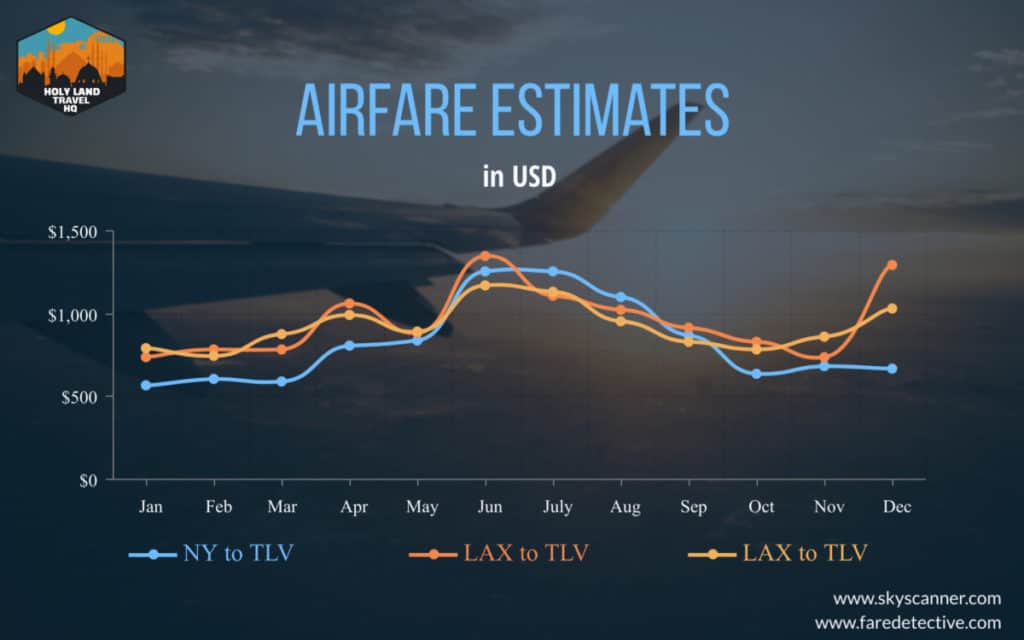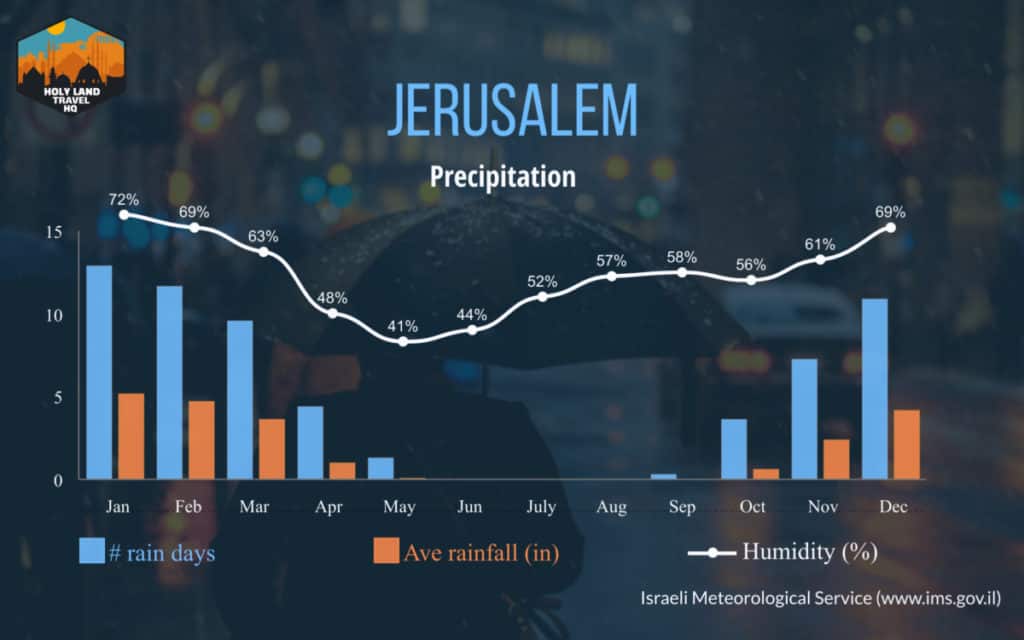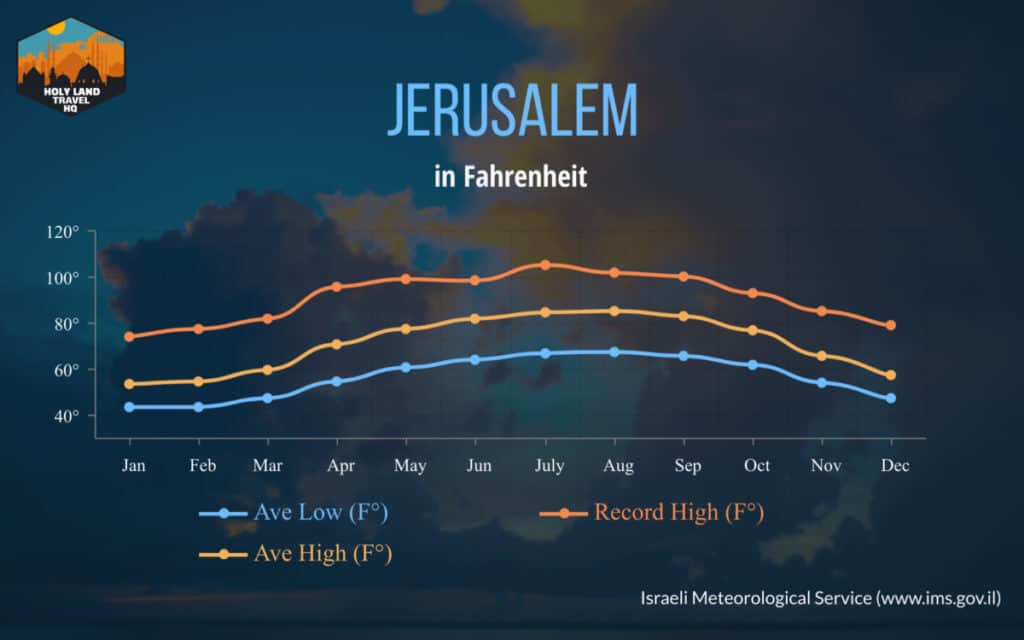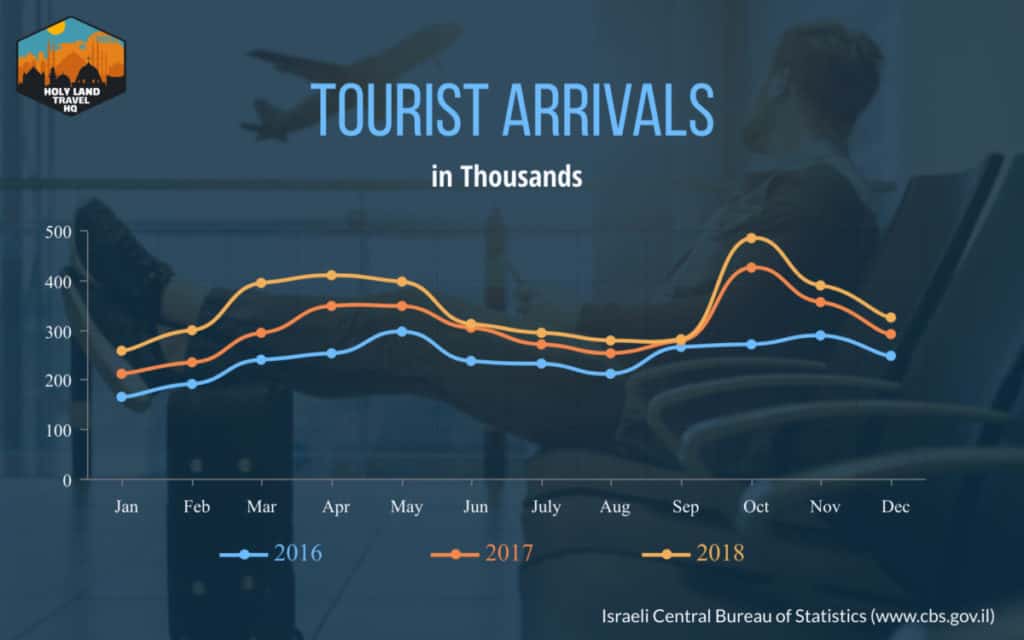
You’re thinking about visiting the Holy Land. Maybe you feel called to go, or maybe it’s just a crazy idea. And now you have questions. When should I go? How does time of year effect cost of airfare. Weather. Crowds. And holidays, both Jewish and Christian. Most often people focus on the weather. It can get pretty hot and dry in the summer months and wet in the winter months. But this isn’t the consideration that drives travel the most.
If you have flexibility in your schedule, the best time to visit the Holy Land is April/May and October/November. This is based on the best fit for the data. However, there are other times throughout the year that are best for different reasons.
When is the best time to fly cheap?
BEST TIME TO TRAVEL FOR CHEAP AIRFARE: January/February and October/November
Tracking airfare prices is a tricky thing. Supply and demand for tickets at certain times effect the cost. WHEN you buy the tickets also contributes. So does the days of the week you fly. Additional factors include your departure airport and route. Needless to say, it gets really complicated.
Generally, airfare between Los Angeles and Tel Aviv ranges from about $650 to $1,300 with occasional spikes to around $3,400. Between New York and Tel Aviv, the range is comparable with spikes around $2,200 according to faredetective.com. Skyscanner.com is similar with a range of $750 to $1,200.

The most expensive months tend to be June/July/August and December. December is in the mix because of Christmas. It’s actually a really good time to go. What better way to celebrate the birth of Christ than to visit Bethlehem at Christmas? Sometimes it even snows.
The cheapest months to travel are October/November (~ $632 to $850) and January/February ($561 to $790). There are a few tour groups that travel in October/November, but not many after the New Year. This happens for a couple reasons. 1) The weather tends to be bad in January and February, as we’ll see in a second; 2) the holidays are over and it’s “get back to work” time; and 3) pocket books are thin after Christmas. January does tend to be a good time for school groups to travel because of this.
When traveling with a tour group, you will know your dates up front. Sometimes tour leaders will have you wait until they have a minimum number of commitments before they tell you to buy tickets. Because of this you might not be able to lock into the price you want. I would recommend following the advice of the tour leader, don’t take the risk.
What time of year is the weather the best for travel to the Holy Land?
BEST TIME TO TRAVEL FOR WEATHER: April/May and October/November
I hope I got your attention with the possibility of snow in December in Jerusalem. The average temperature bracket for December is a low of 42 degrees and high of 57; with an average of 11 days of precipitation. Occasional cold fronts cause snow in the Judean Hills, which surround Jerusalem.

January and February both have an average of 12 days of precipitation with 5.6 inches of rain. The temperature averages are a couple degrees lower than December. This makes a new year Holy Land tour kind of wet.
March is a bit of a transition month and can sometimes be a good month to travel. However, April and May are the best months to travel for weather. Averages range from the mid-50’s to the upper-70’s. October/November tout similar average low’s and highs. The defining factor which breaks April/May from the pack, though, are low levels of humidity. These months can dip below 40% humidity, making the spring the most comfortable time to travel.
The summer months are downright hot. According to the Israel Meteorological Service (Direct link to ims.gov.il). there is 0.00 inches of rain between the months of June through August. July is considered the hottest month, but only by a hair. June is up there as well. The average high is 84 degrees with an average low of 67 degrees. Keep in mind, these are averages. Temperatures can surge into the upper 90’s and low 100’s.

The Israeli Meteorological Service sites 105 degrees as the hottest temperature on record for Jerusalem. The hottest temperature in the Qumran area was 116 degrees. Both were in the month of July.
What time of year is best to avoid crowds in Israel?
BEST TIME TO AVOID CROWDS: January
In 2018, EuroMonitor, an international market research firm, named Jerusalem the fastest growing tourist destination (direct link to article) in the world. According to the Israeli Central Bureau of Statistics (CBS), (direct link to cbs.gov.il)the number of tourist arrivals bounced between 2.5 and 3 million from 2010 to 2016. In 2017, that number broke 3.5 million and in 2018 it reached 4.1 million tourist arrivals.
Although it’s hard to explain the increase, one reason could be the level of security. In 2014 Israel launched Operation Protective Edge (direct link to idf.il) to restore security in the south around Gaza. Despite International backlash against the operation, the result has been a safer tourist environment.

Of the 4.1 million tourists in 2018, the United States topped the CBS’s list with 898,000 tourist arrivals. France came in second with 346,000 tourist arrivals, and Russia was third with 316,000.
According to the CBS, the month with the highest number of tourist arrivals in 2017 and 2018 was October. The lowest was January. The reason for October being the big winner is the Jewish Holiday of Yom Kippur. This is an educated guess though.
No data or analysis points to the purpose of travel for tourist arrivals. Furthermore, the CBS does track admission to the national parks, which oversees all the holy and biblically significant sites. However, the CBS only tracks admission broken down by tourists and Israeli citizens. Furthermore, the data is analyzed by year. And there is no data to show what portion of the total number of tourists visit these sites each month.
The point I’m making here is that tourist arrivals are highest in October and low in July. But it’s very possible that many sites are empty in October and full in July.
How to avoid crowded Jewish holidays.
BEST TIME TO AVOID HOLIDAYS: January and July/August
The two biggest holidays in Christianity are Christmas and Easter. The two Jewish holidays which run at the same time are Hanukah and the Passover. Although, its wrong to assume they are equivalent.
Traveling to the Holy Land to celebrate Christmas has become a thing. Over the last few decades, Christmas and Easter have expanded to included not only local travel, but international travel. With security levels making holy land travel safer, Christmas in the land where Jesus was born and crucified is becoming common.
The biggest Jewish Holidays are Rosh Hashanah and Yom Kippur. They are celebrated ten days apart in September and October. And international travel at this time is on the rise.
The Islamic holiday Ramadan is often celebrated in the late spring or early summer. It’s impact on Holy Land tours is limited though. Many tour bus drivers are Muslim. This doesn’t stop them from earning a buck though. The only tangible effect of Ramadan are the crowds on top of the Temple Mount during prayer time.
Notwithstanding these major celebrations, so far in 2019, April actually has the highest number of tourist arrivals. However, until monthly data is collected on national park admission, we can only hypothesize where these people were headed.
With the lack of significant holidays and the low number of tourist arrivals, January and July/August are the natural choice if you are looking to avoid the holiday crowds.
The school year.
I’m discussing this consideration last because it’s kind of a given. The academic calendar is the biggest driver of travel. This is why Christian tourist crowds are still large in the summer, even though it’s hot and dry. Almost everything in American and Western society, works around the school year.
College grads, families, empty nesters; even the stock market and Congress are conditioned to vacation in the summer months. It’s what we do. Because of this everything else is affected.
Gas prices go up. Airfares rise due to demand. And tour groups travel.
If you have no other choice than to travel in the summer months, you have it easy. Sort of. You don’t need to sort through the data to find the perfect time to go to the Holy Land. You can take in the data passively and respond accordingly.
There is one loophole though. Most academic calendars take a break in December and start again in January. Public schools often start right after the New Year. Colleges on the semester program usually don’t start until late January.
Because of this, college age trips to the Holy Land in January are a thing. For example, Jerusalem University College (direct link to juc.edu), the transfer credit school I went through for my Holy Land courses, offers a short-term trip in January.
Although, a trip in early January may require time off from school for teenagers and kids, it’s worth a look. Especially if teachers are willing to let your kids catch up on school work independently. Or possibly write a report on their travel experience.
Conclusion
BEST OVERALL TIME FOR A HOLY LAND TOUR: April/May and October/November.
Midrange airfare costs, comfortable temperatures, mid to low level UV radiation and lower tourist arrivals makes April/May and October/November the best months to travel the Holy Land. Travel to the Holy Land is a growing business. The number of companies specializing in it have grown too. Your options are endless.
If there was one piece of advice to add here, it would be this. The best determining factor for choosing a tour is who you go with. Figure that out first. Create a list of tour leaders. Compile their tour dates. Then refer to the information provided above.
If you have limiting factors within one or more of the considerations discussed above, then prioritize them accordingly.
Happy Travels.


